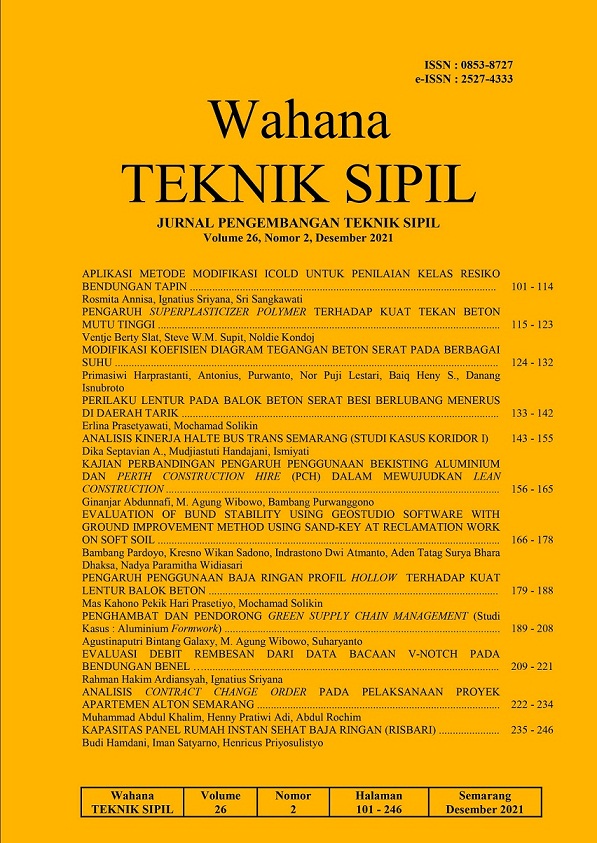APLIKASI METODE MODIFIKASI ICOLD UNTUK PENILAIAN KELAS RESIKO BENDUNGAN TAPIN
DOI:
https://doi.org/10.32497/wahanats.v26i2.3125Keywords:
dam, qualitative, risk class, modified ICOLD, tapinAbstract
The risk assessment of the dam is carried out to estimate the hazard risk of the dam. Risk assessment on dams that have been built and in operation aims to determine the priority of repair and rehabilitation work to improve safety based on the risks that exist in the dam. Research on the risk class assessment of Tapin Dam using the modified ICOLD method includes calculating the risk value on various factors considered, namely the technical physical condition of the dam and related to the implementation of dam safety. The parameters of each factor were obtained from the results of field inspections and technical documents related to the Tapin Dam. Based on the results of the risk assessment, Tapin Dam is classified as a dam with a high risk class. Monitoring the behavior of the dam, regular inspections and post-earthquake conditions, performing routine and periodic maintenance, as well as updating and socializing the RTD are actions that the Tapin dam administrator can take to manage long-term risks that can occur.
References
Adamo, N., Al-Ansari, N., Sissakian, V., Laue, J., & Knutsson, S., 2020, Dam Safety and Earthquakes: Dam Safety and Earthquakes. Earth Sciences and Geotechnical Engineering, 10(6), 23”“40.
Bendungan, S.B., 2014, Inspeksi dan Penilaian Resiko Bendungan Batujai. DOISP Technical Assistance Service for Supporting the Implementation of Dam Safety Assurance & Institutional Improvement.
Buldan, R., Suharyanto, & Sriyana., 2021, Penilaian risiko kegagalan bendungan kedungombo sebagai dasar prioritas pemeliharaan bendungan. Jurnal Mitra Teknik Sipil, 4(3), 557”“570.
BWS Kalimantan II., 2019, Rencana Tindak Darurat Bendungan Tapin.
BWS Kalimantan II., 2020, Laporan Akhir Pelaksanaan Bendungan Tapin.
BWS Kalimantan III., 2021, Laporan Kajian dan Pemantauan Bendungan Tapin.
Ditjen SDA, 2011, Pedoman Teknis Penilaian Risiko.
Indrawan, D., Tanjung, M.I., Sadikin, N., 2013, Penilaian Indeks Resiko Metode Modifikasi Andersen dan Modifikasi ICOLDS untuk 12 Bendungan di Pulau Jawa. Jurnal Sumber Daya Air, 9(2), 93”“104.
Indrawan, D., Tanjung, M.I., Setyawan, H.E., & Sadikin, N., 2015, Analisis Statik dan Dinamik Retakan Memanjang di Puncak Bendungan Sutami. Jurnal Teknik Hidraulik, 6(1), 77”“90.
Paramudawati, M.A.H., Tanjung, M.I., & Ghafara, R., 2020, Penilaian Risiko Keamanan Bendungan di Jawa Timur. Jurnal Teknik Hidraulik, 11, 93”“102.
Suprapto, R.E., & Sadono, K.W.,2021, Penilaian Risiko Bendungan Pelaparado Berbasis Metode Modifikasi ICOLD dan Metode Indeks Risiko. Jurnal Teknik, 42(2), 226”“235. https:// doi.org/10.14710/teknik.v42i2.39715
World Bank, 2021, Portfolio Risk Assessment Using Risk Index. In Good Practice Note on Dam Safety - Technical Note 6 : Portfolio Risk Assessment Using Risk Index. https://doi.org/10. 1596/35490
Yuliningtyas, C.D., Juwono, P.T., & Yuliani, E., 2016, Analisis Probailitas Resiko Kegagalan Bendungan Gerokgak Berdasarkan Metode Pohon Kejadian ( Event Tree ). Jurnal Teknik Pengairan, 7, 7”“16.
Zvanut, P., Turk, M.R., Kryzanowski, A., 2013, Procedure for Dam Safety Risk Analysis and Evaluation of parameters For Large Slovenian Hydropower Dams. International Symposium on “Dam Engineering in Southeast and Middle Europe”, 20th Anniversary of SLOCOLD (Comitato Nazionale Sloveno), 65”“72.
Downloads
Published
Issue
Section
License
Authors who publish with this journal agree to the following terms:Authors retain copyright and grant the journal right of first publication with the work simultaneously licensed under a Creative Commons Attribution License that allows others to share the work with an acknowledgement of the work's authorship and initial publication in this journal.
Authors are able to enter into separate, additional contractual arrangements for the non-exclusive distribution of the journal's published version of the work (e.g., post it to an institutional repository or publish it in a book), with an acknowledgement of its initial publication in this journal.
Authors are permitted and encouraged to post their work online (e.g., in institutional repositories or on their website) prior to and during the submission process, as it can lead to productive exchanges, as well as earlier and greater citation of published work (See The Effect of Open Access).






